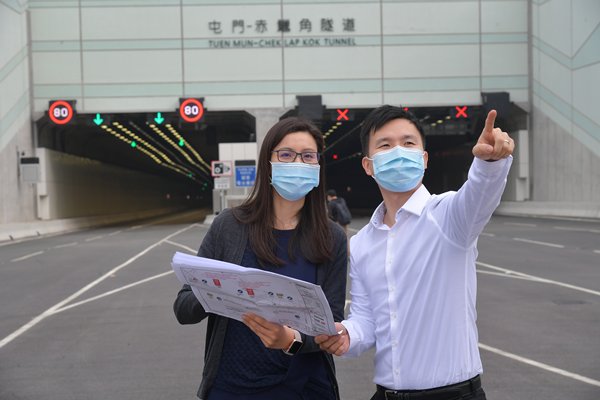New Tunnel An Engineering Marvel

The Tuen Mun-Chek Lap Kok Link Northern Connection will open to traffic on December 27. With the Southern Connection which has been commissioned since 2018, it will form a strategic route connecting the Northwest New Territories with the Hong Kong-Zhuhai-Macao Bridge Hong Kong Port as well as the Hong Kong International Airport and North Lantau.
The 5.5km Northern Connection comprises a 5km Tuen Mun-Chek Lap Kok Tunnel stretching from Tuen Mun South to the Hong Kong Port.
It will shorten the travel distance between Tuen Mun South and the airport by around 22km and the journey time by around 20 minutes.
Hong Kong’s longest tunnel
The tunnel is the longest and deepest subsea road tunnel in Hong Kong. Excavating a tunnel with a diameter of a six-storey building was the Government’s biggest challenge.
The team used innovative methods and techniques to overcome a number of difficulties when constructing the tunnel.
Engineer Ken Cheng was assigned to handle the mega project right after he joined the Highways Department.
“I am honoured to be a part of the construction team. It was a challenge and good opportunity for me as this is the largest project I have ever handled in my career.”
What impressed him the most was being able to use massive tunnel boring machines (TBMs).
This is the first time Hong Kong deployed large-diameter TBMs for tunnel excavation beneath the seabed. One of the TBMs the team deployed was the world’s largest, with a diameter of 17.6m.
Equipped with a rotating steel cutterhead at the front, the machine is designed to pass through different types of soil or rock. It can also excavate under pressurised condition.
He said as compared to the traditional immersed tube method, the use of TBMs for the subsea tunnel construction greatly reduced the dredging and disposal of around 11 million cu m of marine sediment - an amount equivalent to the size of around 4,900 standard-size swimming pools.
Innovative technique
The adoption of TBMs also saved the need to divert the power cables which are now serving the airport and greatly lessened the impact of construction on the environment.
The tunnel’s deepest section is about 60m below sea level. When boring underneath the seabed, specialist hyperbaric workers had to carry out daily maintenance works and overcome an atmospheric pressure nearly six times greater than that at the surface.
Nevertheless, workers’ safety had been ensured and the risk of decompression illness greatly lowered, thanks to the provision of special habitats.
Ken explained that pressurised living chambers were available to accommodate the workers’ 28-day work cycle. Workers were transferred by pressurised shuttles to the excavation chamber to conduct their work and transferred back to the ground surface after working hours. They were also able to eat and rest inside the pressurised living chambers.
The tunnel is also the first in Hong Kong to include a service gallery underneath its carriageway. The service gallery houses utilities which comprise drainage pipes, the fire services system, power supplies and signal control systems.
Highways Department Senior Engineer Liz Li pointed out that this arrangement allows more flexibility for regular maintenance.
“It enables part of the daily maintenance work of utilities to be carried out at the same time the tunnel is in operation. The tunnel does not need to close even if there are emergency repairs. Hence, it minimises disruptions to the public," added Liz.
Momentous milestone in life
Liz has been working for the Government for 10 years and said this is the largest project she has ever worked on. She also faced challenges during the process that she described as an unforgettable experience.
“Due to the outbreak of COVID-19 this year, the supply chain of construction materials and the installation had been affected and the number of workers had also been reduced.
“We had to work closely with the project team to solve the problems, such as sourcing alternative materials in order to minimise the impact on the project," she recalled.
Both Liz and Ken are pleased to see the construction of the tunnel finished and looking forward to celebrating its official opening on December 27.
Ken is eager to take his family on a tour of the tunnel.
“I feel very proud that I took part in this project as it will bring convenience to the public and benefits to Hong Kong. I believe my kids will be proud of me when they know their father participated in this mega project," said Ken.
New Hub Helps Green Tech To Flourish
Last month, the Hong Kong Science & Technology Parks Corporation, or HKSTP, transformed its InnoCentre in Kowloon ... Read more
MICE Tourism Gains Momentum
Ballroom inspections and mahjong sessions may not be what automatically springs to mind when you consider Hong Kong’... Read more
Game Startups Reach New Level
The global video game industry is highly competitive, requiring effective marketing for success. The Hong Kong Game En... Read more
Breast Milk Donations Save Lives
Last April, Ida Chan welcomed her son into the world. He was born a kilogramme lighter than expected, and Ida decided ... Read more
HK Reaches For The Moon
The beauty and mystery of the Moon have captivated the human imagination for millennia. Channelling that fascination i... Read more
Creating Disability-inclusive Jobs
Nestled in the Museum of the War of Resistance & Coastal Defence, Madam Hong Cafe enjoys the spectacular views of ... Read more

